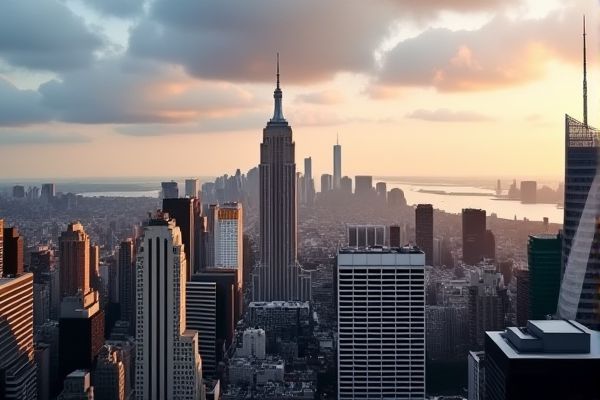
Education system and best schools in New York: Diverse public and private school options. Specialized high schools with entrance exams. Gifted and Talented programs available. Charter schools offer alternative curricula. NYC Department of Education oversees public schools. Zoning determines public school assignments. Private schools often require entrance tests. International Baccalaureate programs available. Consider school rankings and reviews. Availability of after-school enrichment programs.
Diverse public and private school options.
New York offers diverse public and private school options, with several Hudson Valley institutions ranking high in diversity. Public schools like Watervliet Junior High School and New Rochelle High School are noted for their diversity, while private schools such as Hoosac School and the New York Military Academy are among the top diverse private schools in the state, according to Niche's Diversity Report.
Specialized high schools with entrance exams.
The Specialized High Schools in New York City, such as Bronx High School of Science, Brooklyn Technical High School, and Stuyvesant High School, are highly selective public schools that admit students based solely on their performance on the Specialized High Schools Admissions Test (SHSAT), a 3-hour exam administered to 8th and 9th graders. With the exception of Fiorello H. LaGuardia High School, which requires a competitive audition instead, these schools maintain a rigorous standard for entrance. For more information about the test and admission process, you can visit the Princeton Review website, which provides valuable resources and guidance for prospective students.
Gifted and Talented programs available.
In New York City, Gifted and Talented (G&T) programs provide accelerated instruction for exceptional students, beginning as early as kindergarten. These programs feature district-level G&T classes and five citywide G&T schools, which serve students from kindergarten to 8th grade, with one school extending to 12th grade. Admission to these prestigious programs is determined through a combination of teacher evaluations and lottery systems due to limited seats. For more detailed information, you can visit the Gifted and Talented Programs page on the InsideSchools website.
Charter schools offer alternative curricula.
Charter schools in New York City offer alternative and innovative curricula, operating independently from traditional district schools and focusing on specialized programs and educational models to improve student learning and achievement. For a more comprehensive understanding, explore detailed insights on Success Academies, which sheds light on the unique approaches and benefits these schools bring to the educational landscape.
NYC Department of Education oversees public schools.
The New York City Department of Education oversees the largest public school system in the United States, managing over 1,700 public schools that serve more than 1.1 million students. With a budget of nearly $25 billion, it includes several selective specialized high schools like Stuyvesant High School, Bronx High School of Science, and Staten Island Technical High School.
Zoning determines public school assignments.
Zoning laws in New York, particularly in areas like Westchester County, significantly influence public school assignments by restricting housing availability, which in turn segregates neighborhoods and schools. This segregation leads to unequal educational opportunities for low-income and working-class students, as detailed in the report from The Century Foundation on Zoning and Educational Inequality. By shaping the demographic composition of neighborhoods, zoning directly impacts which schools children have access to, perpetuating a cycle of disparity in educational access and quality.
Private schools often require entrance tests.
Private schools in New York City are known for their highly competitive admission processes, often requiring entrance tests as part of their selective admission criteria. This can be challenging for prospective students due to the high demand and rigorous standards. For a deeper insight into this competitive landscape, you can explore The Admission Race, which provides a comprehensive analysis of New York's private school system.
International Baccalaureate programs available.
The International Baccalaureate (IB) programs in New York include the Primary Years Programme (PYP) for ages 3-12, which focuses on inquiry-led and transdisciplinary learning, and the Middle Years Programme (MYP) for ages 11-16, which encourages practical connections between studies and real-world issues. Top IB schools in New York, such as Dwight School, French-American School of New York, and EF Academy New York, offer a range of IB programs including the Diploma Programme. For more information about these programs, explore the International Baccalaureate offerings and how they might benefit students in the New York area.
Consider school rankings and reviews.
When navigating the educational landscape in New York, it's crucial to have access to reliable information regarding school performance and rankings. GreatSchools is an invaluable resource, offering detailed rankings and reviews that highlight top-rated public schools in the area. These rankings take into account factors such as academic performance, equity, and college success, supported by feedback from parents and students. In addition to GreatSchools, SchoolDigger provides comprehensive insights focusing on test scores from NY State Assessments. Their updated rankings for the 2023-24 school year serve as a useful tool for families aiming to make informed decisions about educational opportunities in the city.
Availability of after-school enrichment programs.
The NYC Parks Afterschool Program provides free academic support, physical activity, and diverse enrichment activities for children ages 6 to 13. This program operates on weekdays from 3:00 p.m. to 6:00 p.m. and emphasizes themes including sports, arts, culture, and STEAM. Through these activities, children engage in holistic learning experiences that extend beyond the classroom, fostering both their physical and intellectual development.
